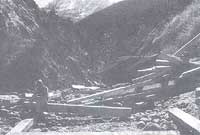Revising an antiquated legislation
Revising an antiquated legislation

THE INDIAN Forest Act (IFA) of 1927 is going to get a new look and name. The Union ministry of environment and forests (MEF) has distributed to all state governments the draft of a new act that provides for adequate community participation in forests and new concepts such as biodiversity conservation, officials say.
The IFA is a legacy of the British, who introduced it to augment revenue and manage forests as state property. But it also restricted the rights and privileges of forest dwellers, leading to conflict and alienation of communities. And, even after Independence, Indian forestry continued to be governed by the colonial rule.
Narrow prospective Says inspector general of forests A K Mukherjee, "The 1927 act was narrow in its perspective as it focussed only on protection and production, but the revised act will aim at a comprehensive management of forests."
The proposed act will be known as the National Resource System Act and will, among other things, give more powers to foresters to check illegal activities inside forests, enhance penalties for forest crimes, streamline settlement of forest land and remove restrictions on tree felling and transportation by tree-growers.
Most of the proposed changes are already in force either through Union acts or amendments to state forest acts. But, says an MEF official, "Our objective is to bring all these within the parameters of a comprehensive act." For instance, restrictions on tree felling and transportation have already been removed in Himachal Pradesh and Uttar Pradesh. The Karnataka Forest Act confers magisterial powers on forest officials to use arms and judicial powers to penalise offenders. By bringing these changes together under one Union act, all states can benefit.
The MEF also wants to bring within the purview of the revised act the state governments' decadal working plans to regulate and plan the raising of forest plantations, regeneration and extraction of timber and minor forest products. At present, these working plans are not covered by the act and are mostly not implemented because of official apathy and lack of funds. Says an MEF official, "The new act will give more teeth to the working plans and state governments can bargain for additional budgetary allocation for implementing them."
The MEF also proposes to diversify the plantation programmes under the working plans, which, since the time of the British, have concentrated on a few species such as sal, teak and pine.
So far, Kerala, West Bengal, Uttar Pradesh, Orissa, Bihar, Goa and Andhra Pradesh have sent in their responses to the draft. Says an MEF official, "There is no major disagreement on the proposed draft and only minor changes prompted by the amended state forest acts have been proposed by these states." For instance, Kerala has suggested that sandal oil and roots of rosewood trees should be classified as forest products.
But the official's optimism may not hold out too long. Once responses from all state governments are received and processed, the draft will be screened by the Inter State Council because forestry is a concurrent subject.
And here is where there may be problems. Debate on the draft in the Inter State Council might be plagued by differences between the MEF and some state governments. In the past few years, the MEF has usurped more powers in deciding how forest lands should be used and has often run into trouble with state governments. The Rajasthan and Haryana governments have been at loggerheads with the MEF over the Forest Conservation Act, which has made Union government clearance mandatory for diversion of forest lands. There are also a few other MEF notifications that seek to regulate development projects around forests.
However, it remains to be seen whether the revised act will be able to throw away the colonial mantle and make forest policies more suitable to its natural resources and people and whether there will be true community participation or not .







